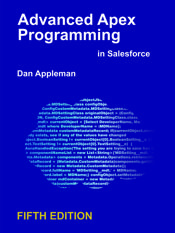by Dan | Jul 26, 2013 | Design Patterns
In my book Advanced Apex Programming, I spend quite a bit of time discussing trigger design patterns. But I’m going to let you in on a little secret – what you find in the book isn’t really a “design pattern”, so much as a design concept.
And despite the chapter name “One trigger to rule them all”, I didn’t originate the idea that it was a good idea to control execution sequence by using just one trigger – experienced Apex developers already knew this. What I think I brought to the table was the idea that we could take advantage of the Apex language object oriented features to implement that concept in some really good, supportable and reliable ways.
Here’s a secret – the examples I used in the book do not, in fact, accurately reflect the framework I used in our own products. The framework we use is considerably more sophisticated. But the examples do reflect the concepts that our framework uses.
I did this because I do not believe there is any one “right” trigger design pattern or framework for everyone and every situation. So my goal in the book was to demonstrate the concepts involved, in the hope that others would build on it – come up with variations of different design patterns and frameworks based on those concepts.
I was thrilled to see the other day a blog post by Hari Krishnan called “An architecture framework to handle triggers in the Force.com platform”. It’s beautiful piece of work (and I do appreciate the shout out). As with our own framework, I don’t think it’s a solution for every scenario, but it does present a very elegant object oriented implementation to the problem. What really struck me was the innovative use of dynamic typing to instantiate objects based on the object type and name. Our own framework doesn’t use that approach, for the obvious reason that it was built before Apex supported dynamic object creation by type, but it’s definitely worth considering for any design going forward.
I don’t know if Hari has worked on the .NET platform (he does mention Java and C#), but the idea of dispatching by name is one we’ve seen in a number of Microsoft frameworks and languages. One can’t help but wonder if, now that we have a real tooling API, someone might come up with a client tool to generate and manage trigger handlers based on a framework like this….
Not only might this automate some of the “plumbing”, but conceivably bring us to that state of Nirvana where, with judicious use of some global interfaces, we might be able to control order of trigger execution across cooperating packages and between packages and Apex code on an organization instance.
Ah well, one can dream. Meanwhile, kudos to Hari for a fine piece of work. Definitely worth a read.
by Dan | Jul 7, 2013 | Design Patterns
A couple of days ago Matt Lacey posted an excellent article on developing for optional Salesforce features. He ended it with a question – how do you ensure code coverage for those orgs that have those features disabled?
For example – let’s say you have code that only runs when multi-currency is enabled on an org:
if(Schema.SObjectType.Opportunity.fields.GetMap().Get('CurrencyIsoCode') != null)
{
// Do this on multi-currency orgs
obj.Put('CurrencyIsoCode', o.Get('CurrencyIsoCode'));
}
How do you get code coverage for this section?
One way to do this is as follows:
First, we refactor out the currency test into it’s own function as follows:
private static Boolean m_IsMultiCurrency = null;
public static Boolean IsMultiCurrencyOrg()
{
if(m_IsMultiCurrency!=null) return m_IsMultiCurrency;
m_IsMultiCurrency = Schema.SObjectType.Opportunity.fields.GetMap().Get('CurrencyIsoCode') != null;
return m_IsMultiCurrency;
}
Though not necessary for this example, in any real application where you have lots of tests for whether it’s a multi-currency org, you may be calling this test fairly often, and each call to Schema.SObjectType.Opportunity.fields.GetMap().Get(‘CurrencyIsoCode’) counts against your limit of 100 Describe calls. This function (which is written to minimize script lines even if called frequently) is a good tradeoff of script lines to reduce Describe calls for most applications.
Next, add a static variable to your application’s class called TestMode
public static Boolean TestMode = false;
Now the code block that runs on multicurrency orgs can look like this:
if(TestMode || IsMultiCurrencyOrg)
{
// Do this on multi-currency orgs
String ISOField = (TestMode && !IsMultiCurrencyOrg())?
'FakeIsoCode' : 'CurrencyIsoCode';
obj.Put(ISOField, o.Get(ISOField));
}
What we’ve effectively done here is allow that block of code to also run when a special TestMode static variable is set. And instead of using the CurrencyIsoCode field which would fail on non-multicurrency orgs, we substitute in any dummy Boolean field. This can be another field on the object that you define, or you can just reuse some existing field that isn’t important for the test. There may be other changes you need to avoid errors in the code, but liberal use of the TestMode variable can help you maximize the code that runs during the test.
Why use a TestMode variable instead of Test.IsRunningTest()? Because the goal here is to get at least one pass through the code, probably in one specialized unit test. You probably won’t want this code to run in every unit test.
With this approach you can achieve both code coverage and, with clever choice of fields and field initialization, functional test results, even on orgs where a feature is disabled.

